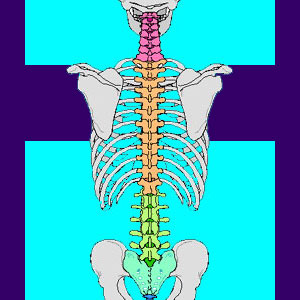
The human spine is a miracle of natural engineering and design, allowing our species to become the most successful on this planet and facilitating a staggeringly diverse range of physical functionality. Scientists credit the vertebral column for providing early humans with a huge advantage over competitive species that still utilized all four limbs for mobility. The upright spinal structure allowed incredible specialization of the hands and feet, giving mankind the foundation to evolve into the complex and varied lifeform we embody today.
This essay examines the composition, structure and functionality of the human vertebral column.
Human Spine Tissue Types
The spine consists primarily of individual bones called vertebrae and spacer tissues called intervertebral discs. The discs help to insulate each bone against shock and stress, as well as provide flexibility to the backbone.
The spine is separated into sections starting at the head and ending at the tailbone, consisting of the cervical region, the thoracic region, the lumbar region, the sacral region and the coccyx region. There are also frontier zones in the spine where one region meets the next, including the cervicothoracic juncture, the thoracolumbar juncture, the lumbosacral juncture and the sacrococcygeal juncture.
Vertebrae interlock with the surrounding bones above and below at locations called facet joints. These structures are the bony projections that one can feel on the back and even see in many cases.
The spinal cord traverses the central spinal canal, also known as the vertebral canal. From this central cord, nerve roots branch off and exit the canal at each vertebral level. The central canal also contains various levels of membranes which surround the spinal cord and nerves. The central canal membranes are filled with cerebral spinal fluid, which cushions the neurological tissues and helps to provide homeostatic regulation.
Ligaments help to govern the range of movement in the vertebral column and also provide stability. The main three ligaments include the ligamentum flavum on the posterior side of the spinal canal, the posterior longitudinal ligament on the anterior side of the spinal canal and the anterior longitudinal ligament on the anterior side of the vertebral column.
Spinal Curvature in Humans
The spine is multiply curved to better provide weight bearing and shock insulation qualities. The cervical spine demonstrates a lordotic curvature, which means that the open end of the curve faces the posterior of the body. The thoracic spine maintains a kyphotic curve, meaning that the open end of the curve faces the anterior of the body. The lumbar spine demonstrates a lordotic curve, as well, so that the open end once again faces the posterior of the body. The sacrum and coccyx bend back around in a kyphotic curve, with the open end facing the anterior plane of the body.
A typical spine should not curve side to side and will appear as a straight line when viewed from the objective anterior or posterior view. However, insignificant side to side spinal curvatures are relatively common and do not truly qualify to be called scoliosis.
Bottom Line on the Human Spine
The spine enjoys a wonderful organic design, since it is both protective and physically enabling. The spine ties into the ribcage, providing structural support for the entire upper body and considerable defense for the internal organs. However, the individual parts of the spine are flexible and each vertebral level can move independently of those around it. This creates an incredible range of motion which allows humans to be some of the most athletic and physically-gifted creatures on Earth.
It is normal, expected and universal for the spine to age, just like the rest of our bodies. The conditions known as spinal osteoarthritis and degenerative disc disease are seen in virtually every adult human to one degree or another. Being diagnosed with either of these conditions, or a host of other common potential back pain causes, should be of no surprise, since the spine takes tremendous abuse and deteriorates throughout its lifespan.





